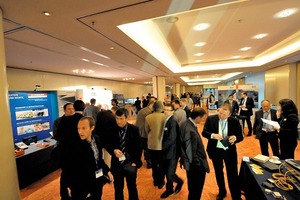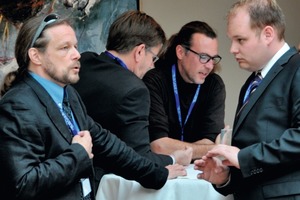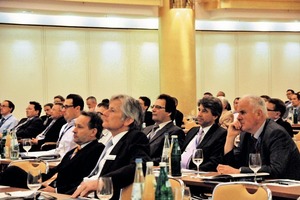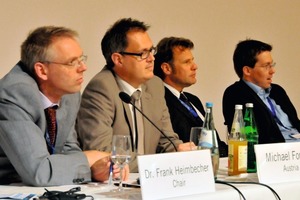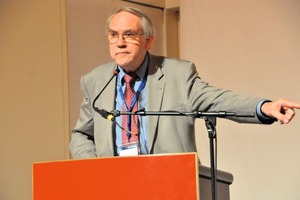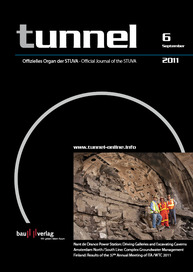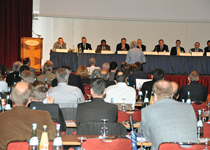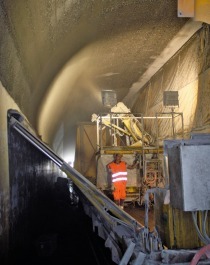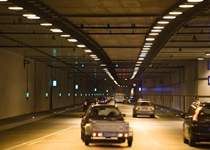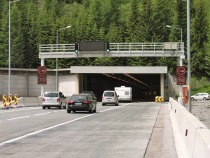Traffic and Safety in Road Tunnels
Is there a link between underground transportation facilities and the events in April 2010 when relatively unexpected a volcano on Iceland erupted and grounded air traffic throughout Europe and in turn a large portion of public life? – The effects were clearly able to demonstrate just what mobility means to our society nowadays. And they also demonstrated just how sensitively the transport sector reacts to such influences.
Tunnels in particular often represent bottlenecks within the transport network. As a consequence they require special attention with respect to their safety and operation, above all their reliability.
The eruption of the volcano Eyjafjallajökull fortunately did not lead to any particular danger for life and limb and luckily the effects of the Icelandic volcano Grimsvötn in May 2011 were far less dramatic than originally expected. In comparison disturbances occurring in road tunnels in many cases cause life-threatening situations for motorists.
There will always be incidents, which have unexpected effects – the erupting of the two volcanoes once again underlined this fact. But for this very reason it remains a task of utmost priority for those, who are engaged in building, furnishing and operating road tunnels, to minimise the known dangers and risks.
Towards this end Pöyry Infra Traffic staged the international congress “Traffic and Safety in Road Tunnels” in Hamburg for the 6th time from May 10 to 12, 2011. With this congress Pöyry supports the European Road Safety Charter. You can obtain further details by accessing www.erscharter.eu
The congress presented, dealt with and discussed the following main themes:
Guidelines and codes of practice – regional and international aspects
The behaviour of motorists
Risk analysis
Guidance and evacuation systems
Fire protection
- stationary extinguishing systems
- ventilation and exhaust systems
Fire, incident and danger detection and location.
This all was the outcome after numerous experts had handed in their drafts following a call for papers in June of last year. A committee of four consisting of Sabine Vogler (Pöyry Infra Traffic, Germany), Prof. Alfred Haack (STUVA, Germany), Didier Lacroix (CETU, France) and Roberto Arditi (SINA S.p.A., Italy) then made their choice.
Following a welcoming address by Sabine Vogler, Federico Lenti from the Italian motorway operator Autostrada dei Fiori reported on the implementation of European guideline 2004/54/EC and which role this plays in maintaining twin-bore, two-lane tunnels on the E 80. The contribution by Axel Bassler (Gruner AG, Switzerland) presented challenges for tunnel safety in mountainous regions and the measures for testing safety in tunnels in the Canton of Graubünden.
Under the caption “Motorists’ Behaviour” Günter Rattei (ASFINAG, Austria) examined the results of an evaluation of data, which deal with the issue of whether safety installations in tunnels are used the way they should be. Dr. Alessandro Calvi from the University of Rome presented the outcome of a study from a virtual driving scenario. Prof. Thomas Jürgensohn from Human-Factors-Consult in Berlin also dealt with a simulated journey through the Elbe Tunnel enlargement (top cover) in Hamburg-Stellingen. In the study carried out on behalf of the DEGES the optimal size of the permanent light signals was established through determining the visual field.
On Day 2 the programme was devoted to risk analysis. Dr. Matthias Wehner and Jens König from HBI Haerter (Germany) put forward a quantitative risk analysis in keeping with RABT standards as well as a method for categorising in accordance with ADR 2007.
Christoph Sistenich from the Federal Highways Institute (BASt, Germany) and Christof Neumann (ILF Beratende Ingenieure, Austria) delivered a joint presentation devoted to the results of a comparative study on various methodical approaches for quantitative risk analysis of road tunnels in Germany. Bernhard Kohl (also ILF Beratende Ingenieure) supplied a paper on the extended application of risk analysis at the Karawanken Tunnel in Austria with the assistance of the TuRisMo risk model.
The following section of papers was devoted to guidance and evacuation systems and was chaired by Dr. Frank Heimbecher from the BASt. The speakers were Michael Forster and Mario Goldbrich of Swareflex from Austria, Alexander Wierer from the ASFINAG as well as Juha Huovilainen of MariMils from Finland. Their papers examined the application of LED technology in tunnels both for traffic guidance as well as evacuation purposes.
Two further lectures on Day 2 of the congress touched on the topic of fire protection, which was continued on Day 3: Dr. Erik Iglesias from the Hagerbach Test Gallery looked at fire protection in conjunction with the maintenance of road tunnel or to be more precise in renewing the concrete; Bernd Konrath (IFI – Industrieaerodynamik) from Aachen introduced his audience to findings stemming from realistic fire tests of recent years.
A get-together on the evening of Day 2 afforded participants an excellent opportunity to exchange views with fellow experts in an informal atmosphere, develop ideas or quite simply relax and enjoy the food and mild temperatures against the backdrop of the Port of Hamburg.
Continuing the topic fire protection on Day 3 of Traffic and Safety in Road Tunnels, 4 speakers devoted their papers to “Stationary Extinguishing Systems”. Pekka Nikkarika (Marloff, Finland) and Max Lakkonen (Fogtec, Germany) presented special aspects of water mist extinguishing units. Günter Dorau (OneSeven, Germany) explained the advantages of extinguishing fires in road tunnels with the aid of compressed air foam. Rajko Rothe (IFAB, Germany) reported on the SOLIT2 research project.
The papers presented by 2 further speakers dealt with ventilation and exhaust systems: Reto Buchmann (Pöyry Infra AG, Switzerland) talked on dimensioning such systems; Jürgen Steltmann (TLT-Turbo, Germany) put forward a new exhaust fan taking the retrofitting programme for the Hamburg Elbe Tunnel as an example.
The final series of papers examined the subject of fire, incident and danger detection and location and was explained from different perspectives by 6 authors: Dr. Franz Graf (Joanneum Research, Austria) reported on the world’s first acoustic monitoring system in a road tunnel. Stephan Pouh (Siemens AG, Germany) touched on the good results from the SKRIBT research project, which related to the detection of potentially dangerous vehicles. Dr. Henrik Hoff (AP Sensing, Germany) dealt with the detection and monitoring of fire seats. Dr. Ludger Siepelmeyer as an expert for preventive fire protection talked on fire detection per video. Dr. Arnd Rogner’s (Metaphysics, Switzerland) paper looked at the issue of whether a fire can best be detected by measuring temperature or visibility. Dr. Peter Böhnke (ave Verkehrs- und Informationstechnik, Germany), explained the detection of incidents in road tunnels using innovative induction loops taking the current example of the Hamburg Elbe Tunnel. At the end of 3 days containing numerous interesting papers, Prof. Alfred Haack provided his by now traditional closing remarks, summing up the individual contributions with more than a hint of irony.
The proceedings can be ordered from Pöyry Infra Traffic stored on a USB stick.
Traffic and Safety in Road Tunnels was accompanied by an international exhibition, at which some 30 companies presented products and services as well as their latest developments. You can access a list of the exhibiting firms as well as further information at www.tunnelkongress.de.
